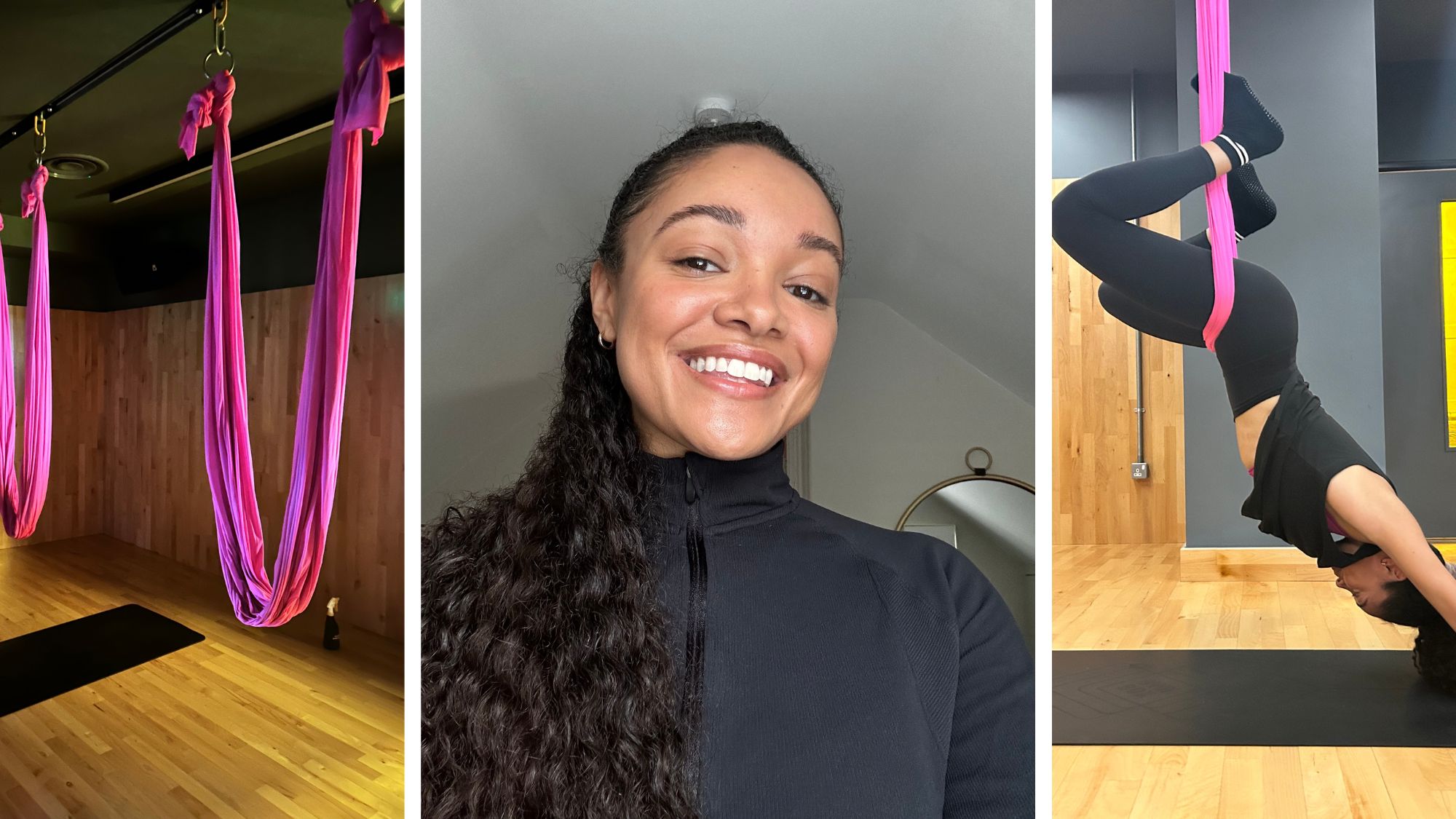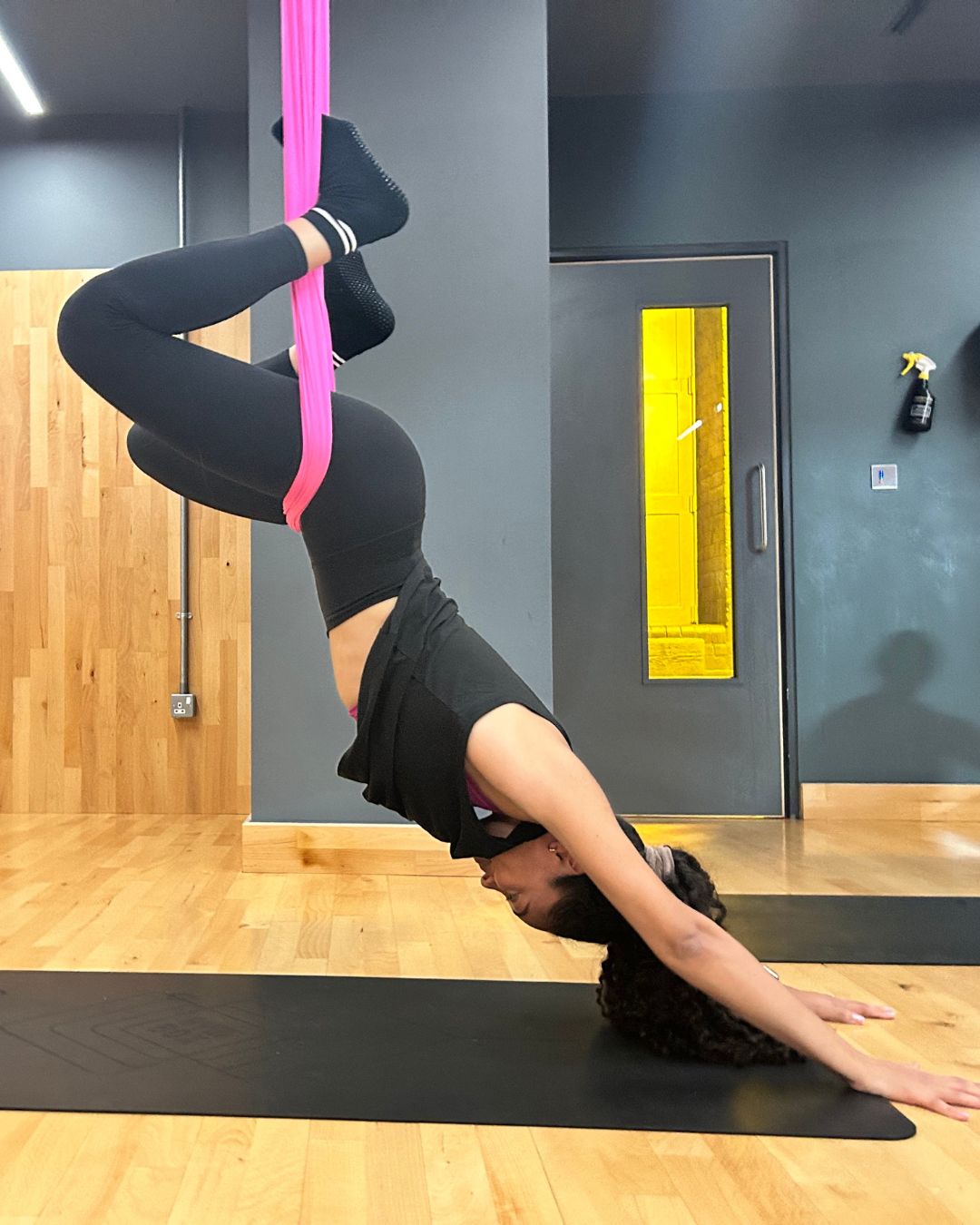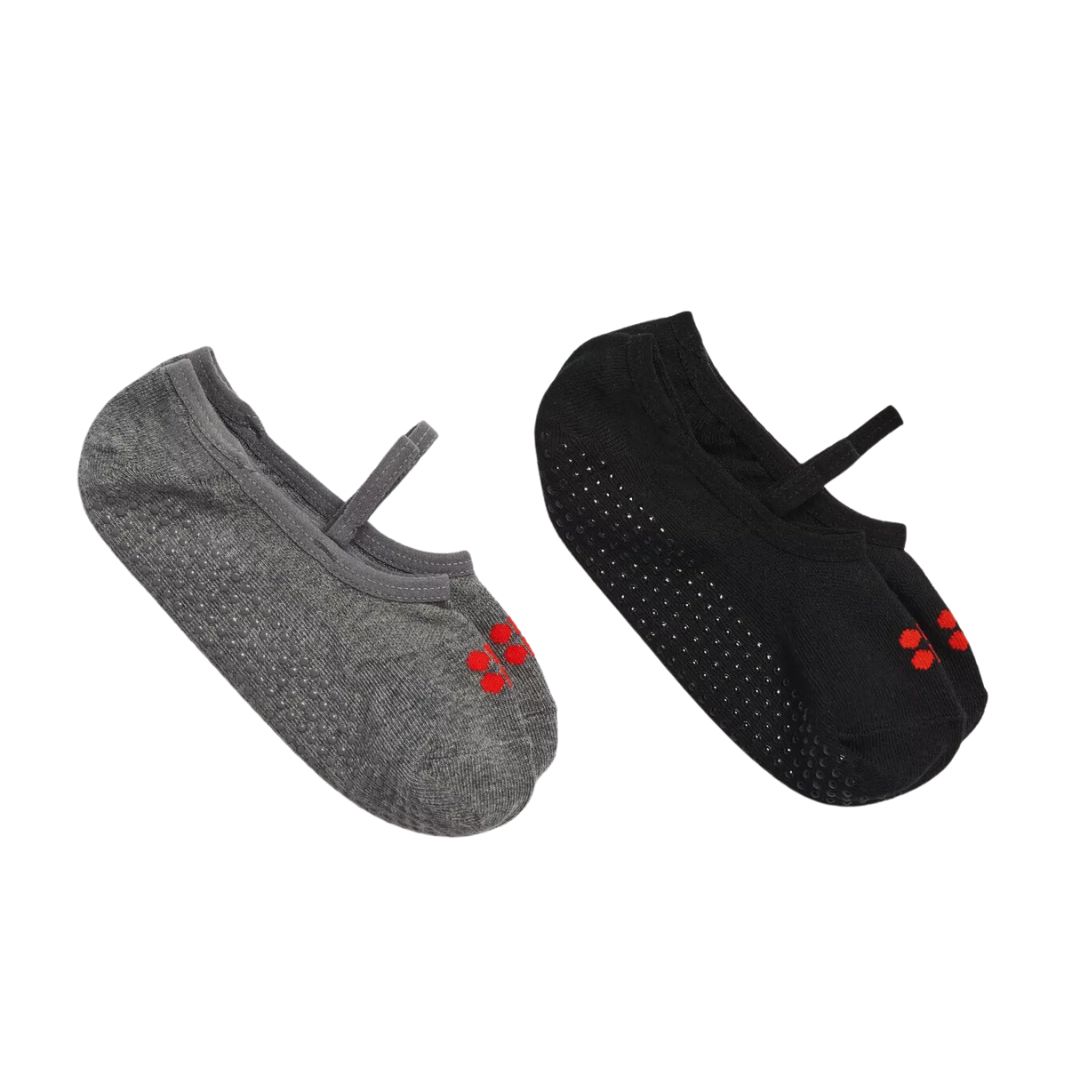Search for this alternative form of Pilates is up by 4,800%, so I tried it - and was surprised at how much I learnt
My practice has been taken to new heights — literally.


Trying out new classes is my kryptonite. So when I spotted that Google Searches around the gravity-defying practice of aerial Pilates was up by 4800%, I just knew I had to see what all the fuss was about.
Pilates workouts, in 2024, come in many different guises. From Wall Pilates, to Reformer Pilates, to Mat Pilates and more dynamic iterations, like F45 Pilates, I’ve been lucky enough to try most of these low-impact practices and have been impressed by them all. However, the lure of taking my Pilates practice up a level is what lured me to the aerial kind.
As you may have already guessed, aerial Pilates takes many of the principles from Joseph Pilates’ original creation of Contrology back in the 1920s. But instead of using a moving carriage as you might in a Reformer class, or a tower in a Tower Pilates sesh, aerial Pilates uses a floating hammock to challenge alignment, balance, core stability, flexibility, and strength.
While studies on aerial Pilates are few and far between, one 2019 article published in the Journal of Morphology and Kinesiology concludes that aerial fitness may be another recreational activity that could be used to "maintain higher levels of flexibility, balance, cardiorespiratory fitness, and strength.”
Inspired to take my Pilates practice to new heights, I headed down to Gymbox’s Victoria branch for a 45-minute Aerial Pilates session. To find out what happened, keep scrolling. And while you’re here, you might also be interested in reading our guides on the best Pilates exercises for beginners, best Pilates core moves, best core sculpting Pilates moves and the best Pilates bar exercises, too. Learn the basics with our explainer on the best intermediate Pilates moves, here.
I tried an Aerial Pilates class as it soars in search - and, wow
What is aerial Pilates?
“Aerial Pilates is a bodywork system named after the principles we’ve inherited from Joseph Pilates,” Hester Campbell, aerial master trainer and Pilates instructor at Gymbox, explains.
In this Pilates practice, an aerial hammock is used to challenge your strength, alignment, core stability, flexibility and balance. “We also use the aerial hammock for the additional benefit of hanging and inverted exercises to restore space within an often compressed body,” Campbell adds.
Celebrity news, beauty, fashion advice, and fascinating features, delivered straight to your inbox!
Who invented aerial Pilates?
Back in the 20th century, Joseph Pilates developed Contrology — the original name of the mind-body practice we now know as Pilates. Since then, countless reiterations of the low-impact exercise have been created with the same methodology in mind. From Wall Pilates and Dynamic Pilates to Aerial Pilates, too.
At Gymbox, trained dancer, CircusFit pro and Pilates instructor Campbell, who has been qualified to teach fitness since 1996, developed the London-based gym’s own Aerial Pilates class back in 2013. “I used my knowledge of Pilates methodology, combined with my knowledge of circus aerial arts and calisthenics to create a class," Campbell says. “Later that year, I wrote an instructor training manual, had it accredited and have been training teachers to deliver Aerial Pilates classes since 2014. Teachers train up at Gymbox with me to become Aerial Pilates Instructors every year.”
What are the benefits of Aerial Pilates?
If you're a Pilates enthusiast, you'll already know that this low-impact mind-body workout comes with a long list of benefits. For example, the practice works hard to strengthen and tone your muscles while also promising to improve your posture and flexibility.
And Aerial Pilates can do all this and more! For starters, much like Mat Pilates, taking your class mid-air can help with your alignment. “The hammock will challenge us in new ways,” Campbell says. “So if something is off with your alignment, the hammock will show you that immediately.”
The hammock also tests your strength and conditions your body in new ways, because you can't cheat the exercises. “If you do try to cheat and not perform exercises properly, you can possibly lose your balance and fall over,” the expert says. “It's not dangerous,” Campbell reiterates. “But Aerial Pilates promotes moving in a considered and controlled way. The hammock becomes a clear focal point and assists us in aiming for perfection, in a shorter time frame than we might experience on a mat, or on a Pilates reformer machine.”
Aerial Pilates is also a form of inversion therapy, which involves being upside down or at an inverted angle while hanging by the legs, ankles, or feet. “Inversion therapy is known for improving circulation, stimulating lymphatic drainage and putting length and space back into compressed parts of the body (particularly the neck, back and hips),” Campbell says. According to a 2019 article published in the International Journal of Engineering Research & Technology, inverting can also decrease back pain, relax muscles and increase joint mobility and flexibility.
But above all? “Aerial Pilates is also a lot of fun,” Campbell insists. “The hammocks are a wonderful tool for exercise, but they are fun to play with, offer endless possibilities for progression and are so comfy to relax in, too!.”
What muscles does Aerial Pilates work?
Another massive benefit of this gravity-defying practice? Aerial Pilates is a full-body workout, so it will hit every muscle in your body.
“More than individual muscles, Aerial Pilates focuses on chains of muscles,” Campbell explains. “For example, the muscles in the arches of the feet connect with the muscles of the inside thighs, which connect with the abdominals, up through the back of the neck to the crown of the head. We focus on becoming more aware of those connections which allow us to do complicated balancing and floating strength exercises.”
Top tips for trying aerial Pilates as a beginner?
- Have patience. “It gets easier,” Campbell maintains.
- Build trust within yourself, with your instructor and with the hammock. “It’s scary to try something new, and that part is the biggest hurdle,” Campbell says.
- Take what you learn in class, out of the studio. “For example, practice your pelvic floor exercise (it’s a secret workout, no one knows you are doing it) practice squeezing glutes, pulling in your abs and lifting up out of your hips when you are walking,” Campbell adds. “You'll improve your whole posture, your confidence, and your overall feeling of well being.”
Aerial Pilates — what I learned from my class
1. Aerial Pilates is suitable for beginners
As I found out first-hand, it doesn’t matter whether you’ve done Aerial Pilates forever or never, during the 45-minute class, the expert showed and told me how to do the moves before expecting us all to follow suit.
The class was also given a range of regressions and progressions, so you could tailor the moves to you and your body. This meant even though it was a group session, everyone got the most out of their own individual practice.
2. You won’t spend all of the class in the air
Those uneasy with heights: rejoice! It turns out that an Aerial Pilates class won’t see you suspended right from the start of the class right up until the end.
Yes, there was a range of gravity-defying poses and stretches spent in the hammock. But there was also a mix of mat exercises and hammock hangs.
For example, at some points, we'd use the secure 3m stretch of fabric to help us rise up and balance on the balls of our feet while pulling down on either side of the hammock. This forced me to use the muscles in my hands and forearms and at the same time, we were reminded to use our core muscles to stop us from swinging from side to side.

Becks trying aerial Pilates in studio
3. You’ve got to trust your body, the hammock and the instructor
As someone who spends the majority of the day sat behind a screen, learning how to hoist parts (or all) of your body in the air isn’t something that occurs on the daily.
During the class, we were challenged to do a series of controlled poses using the hammock, like a suspended plank pose and an aerial bridge without swinging the hammock from side to side.
Right at the end, after a little encouragement, I even tried a deep hip-loosening stretch that went against gravity, which involved using just the hammock and my legs to hold me up.
Did I think I could do this? Not at first. But did I listen to the instructor and try it under expert supervision? The pictures don’t lie. Aerial Pilates showed me that your body can be capable of new (and tricky) things.
4. You might feel taller
“How was it?” Campbell asks me after the session came to a close. My answer? “Taller”. Which makes sense, considering Campbell says Aerial Pilates can “lengthen the spine and decompress vertebrae and hip joints”.
I walked into the class with my shoulders up to my ears and a stiffness in my hips thanks to my rather sedentary job. But 45-minutes later, I felt like my body had been ‘reset’ to its factory settings. My posture felt like it had been reconfigured, my spine felt like it had been lengthened and my hips breathed a sign of relief after all the prolonged stretches and positions the session challenged me with.
The verdict
It might have only been one class. But I feel like a weight has been lifted — both literally and figuratively speaking. The class ended with a body scan while suspended in the super soft hammock with the fabric keeping you safe and sound and acting as a cocoon.
The instructor asked us to stay there for as long as our minds and bodies needed. “We always finish class with a relaxing body scan to process and reflect on all our hard work," Campbell explains. And after my 45-minute session, I feel like my mind, body and soul has been restored!

Becks after trying her aerial Pilates class
Shop MC UK's go-to workout kit now:
What is the difference between aerial yoga and aerial pilates?
Quite a few things! “Yoga is a complex system of health with origins that date back more than 5000 years,” Hester Campbell, aerial master trainer and Pilates instructor at Gymbox, explains. “Aerial Yoga uses asana (pose) and pranayama (breathwork with the aerial hammock). Aerial Pilates, by contrast, uses the classical principles of Joseph Pilates, which are the following: Alignment, Balance, Breathing, Control, Concentration, Centering and Flow," Campbell adds.
“The main difference is that yoga has an aspect of spiritual experience moving towards enlightenment and originates from the East," the expert explains. "Pilates was German and his approach to health was very much a Western European one — he studied every form of movement he could find (including yoga) and with his knowledge of gymnastics, bodybuilding and naturopathic medicine and strived to help all people become stronger and healthier versions of themselves.”

Rebecca, or Becks, is a freelance journalist with more than ten years of experience in the industry. She specialises in all things health and lifestyle and has written for a number of brands including Women's Health, Stylist, the Evening Standard, Good Housekeeping, The Telegraph, Live Science, Tom's Guide and Fit&Well. Becks also writes copy for a number of brands and small businesses.
When she's not weight training, tracking down the best gym leggings, reading a book or at her desk typing away, you'll find her in the kitchen perfecting a new recipe or bake.


